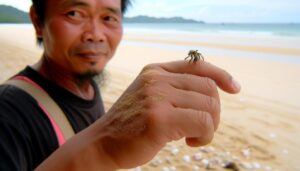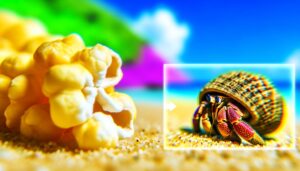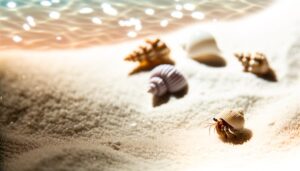Do Hermit Crabs Eat Moss?
Yes, hermit crabs can eat fish, but it's not their primary food source. As opportunistic omnivores, they mostly consume plant and animal matter like algae, decaying wood, and small invertebrates.
While they coexist peacefully with fish, they might target small, slow-moving fish if food is scarce. Their predatory instincts can kick in, and they'll use their strong pincers to capture prey.
To avoid conflicts in a tank environment, choose non-aggressive fish like gobies and provide enough detritus and organic matter. Discovering the nuances of their diet and behavior will enhance your understanding of maintaining a harmonious tank.

Key Takeaways
- Hermit crabs can exhibit predatory instincts and target small, slow-moving fish when food is scarce.
- They primarily scavenge on detritus and organic matter rather than actively hunting fish.
- Peaceful fish like gobies and small shrimp are generally safe tank mates for hermit crabs.
- Hermit crabs use strong pincers to capture and crush prey if they decide to hunt.
- Not all hermit crabs display predatory behavior towards fish in captivity.
Hermit Crab Diet Overview
When examining the diet of hermit crabs, you'll find that they're opportunistic omnivores, consuming a variety of plant and animal matter available in their habitat. Hermit crabs thrive on a diverse diet, which can include algae, decaying wood, and fallen fruit. They also consume small invertebrates and detritus.
Studies indicate that they benefit from a balanced intake of proteins and carbohydrates, essential for their growth and shell maintenance. By understanding their dietary needs, you can better cater to these creatures, whether in captivity or when supporting conservation efforts.
Keep in mind that providing a varied diet not only secures their physical health but also promotes natural foraging behaviors, essential for their overall well-being.
Natural Habitat and Behavior
You'll find hermit crabs primarily in coastal and marine environments, often hiding under rocks or within tidal pools.
Their nocturnal feeding habits indicate an adaptation to avoid predators and scavenge for food under the cover of darkness.
These behaviors suggest a highly adaptive nature, enabling them to thrive in diverse and resource-scarce habitats.
Coastal and Marine Environments
Hermit crabs primarily inhabit coastal and marine environments, where their behavior is intricately adapted to the dynamic conditions of tide pools, sandy shores, and coral reefs.
You'll find these crabs:
- Navigating tide pools: They expertly maneuver through rocky crevices, searching for food and shelter.
- Occupying sandy shores: They burrow into the sand to avoid predators and extreme temperatures.
- Exploring coral reefs: They utilize the complex structures for protection and scavenging opportunities.
- Reacting to tidal changes: Their activity patterns align with the ebb and flow of tides, ensuring optimal access to resources.
These environments provide the necessary resources for hermit crabs to thrive, showcasing their remarkable adaptability and resilience.
Understanding their natural habitat helps you better appreciate their ecological role and the importance of preserving these coastal ecosystems.
Nocturnal Feeding Habits
In the cover of night, you'll observe that hermit crabs emerge from their shelters to forage, taking advantage of reduced predation risk and the availability of diverse food sources. These nocturnal activities are essential for their survival, as darkness offers a safer environment.
Studies show that hermit crabs utilize their keen sense of smell to locate decaying organic matter, algae, and small invertebrates. While they primarily consume detritus, they sometimes scavenge on dead fish, contributing to the ecosystem's nutrient cycle.
Interaction With Fish
Understanding the dynamics between hermit crabs and fish involves examining their behaviors, territorial tendencies, and dietary interactions in shared aquatic environments. You'll notice that hermit crabs and fish often coexist peacefully, but their interactions can vary.
- Behavioral Observations: Hermit crabs are scavengers, often seen foraging for detritus, while fish may swim around them, largely uninterested.
- Territorial Tendencies: Hermit crabs typically occupy small areas, making them less likely to encroach on a fish's territory.
- Dietary Interactions: They primarily feed on leftover food and organic matter, rarely competing directly with fish.
- Symbiotic Relationships: In some cases, hermit crabs may clean up after fish, reducing waste and maintaining tank health.
This understanding highlights how hermit crabs contribute positively to their shared habitats.
Predatory Instincts
Despite their reputation as peaceful scavengers, you might be surprised to learn that hermit crabs can exhibit predatory instincts under certain conditions. When food is scarce, they might target small, slow-moving fish. Research shows that their strong pincers can effectively capture and crush prey.
Additionally, hermit crabs have been observed cornering sick or injured fish, exploiting their vulnerability. You'll notice that their behavior changes, becoming more aggressive and persistent. This predatory nature isn't common in all hermit crabs but can arise in specific situations.
Understanding these instincts helps you create a balanced environment where all creatures can thrive without undue stress or harm. By recognizing these behaviors, you can better serve and care for your aquatic community.
Safe Tank Mates
When considering safe tank mates for your hermit crabs, you'll want to focus on compatible species choices that minimize predatory risks. Studies show that small, non-aggressive fish like gobies or blennies can coexist peacefully with hermit crabs.
Additionally, maintaining environmental harmony through proper tank setup and monitoring can further reduce chances of conflict.
Compatible Species Choices
Choosing compatible species for a tank with hermit crabs involves considering the dietary habits, environmental needs, and temperaments of potential tank mates to guarantee a harmonious aquatic habitat. To establish a balanced environment, follow these guidelines:
- Small, Peaceful Fish: Opt for species like neon tetras or guppies. They're less likely to disrupt your hermit crabs.
- Snails: Snails, such as Nerite or Mystery snails, coexist well with hermit crabs and help maintain the tank's cleanliness.
- Shrimp: Cherry or ghost shrimp are excellent additions, as they're non-aggressive and contribute to tank upkeep.
- Non-Aggressive Algae Eaters: Otocinclus catfish can help manage algae without posing a threat to hermit crabs.
Ensuring compatibility will establish a thriving, stress-free environment for all tank inhabitants.
Avoiding Predatory Risks
To ensure your hermit crabs are safe and thriving, you must identify and avoid tank mates that exhibit predatory behavior. Predatory fish like triggerfish or certain species of wrasse pose significant risks. Studies show that these fish can be aggressive, often viewing hermit crabs as easy prey.
Instead, consider peaceful species like snails, small gobies, or algae eaters. These tank mates are less likely to cause harm. Observing their interactions is essential; erratic movements or signs of stress in your hermit crabs indicate potential threats.
Environmental Harmony Tips
Creating a harmonious environment for your hermit crabs involves selecting tank mates that contribute to a balanced ecosystem and minimize stress. It's essential to choose species that coexist peacefully and won't compete aggressively for resources.
Here are four safe tank mate options:
- Snails: They help clean the tank by consuming algae and detritus, complementing the hermit crab's natural scavenging behavior.
- Small, non-aggressive fish: Species like guppies or tetras won't pose a threat and can coexist peacefully.
- Shrimps: Shrimps, such as ghost or cherry shrimp, are excellent tank cleaners and non-aggressive.
- Mollusks: They contribute to the tank's cleanliness and don't interfere with hermit crabs.
Feeding Guidelines
Hermit crabs flourish on a diverse diet, so providing a variety of food options that include both plant-based and animal-based nutrients is crucial. You should offer them fresh vegetables, fruits, and seaweed to make sure they receive necessary vitamins and minerals.
Supplement their diet with protein sources like boiled eggs, shrimp, and occasional fish. Studies indicate that a balanced diet supports their growth and shell development. Avoid processed foods and artificial additives, as these can harm their health.
Regularly rotate their food to prevent nutrient deficiencies. By offering a varied and diverse diet, you guarantee your hermit crabs maintain excellent health and energy, ultimately contributing to their well-being and longevity.
Preventing Conflicts
Preventing conflicts among hermit crabs requires understanding their territorial nature and providing ample resources like shells, food, and space. You'll need to make sure that each crab has what it needs to thrive without competing for resources.
- Variety of Shells: Offer multiple sizes and types of shells to reduce competition.
- Adequate Space: Provide a spacious habitat to let each crab establish its territory.
- Regular Feeding: Feed them consistently with a balanced diet to minimize food-related conflicts.
- Observation: Regularly monitor their interactions to identify and address any emerging issues.
Conclusion
Imagine your hermit crab, its claws delicately sifting through grains of sand, content with its diverse diet. By understanding their natural tendencies and carefully choosing tank mates, you'll create a harmonious underwater world.
Hermit crabs, while occasionally opportunistic, aren't innate fish predators. Stick to a balanced feeding routine and vigilant observation to prevent conflicts. Your focus on detail guarantees a thriving, peaceful aquarium where every creature, from the tiniest shrimp to the most colorful fish, coexists happily.






